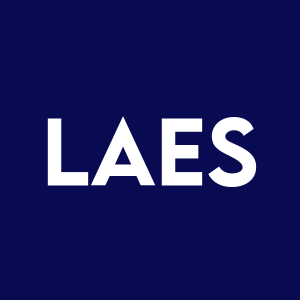2025 Expected to be a Pivotal Year for SEALSQ and WISeKey in Quantum and Post-Quantum Technologies
Rhea-AI Summary
SEALSQ Corp (NASDAQ: LAES) announced that 2025 is expected to be a landmark year for their quantum technology advancements. The company, along with parent WISeKey, is focusing on post-quantum algorithms and semiconductor innovations while collaborating with NIST's National Cybersecurity Center of Excellence on developing the first Quantum-Resistant USB Token demonstrator.
The initiative, part of SEALSQ's QUASARS project, implements quantum-resistant algorithms like CRYSTALS-Kyber and CRYSTALS-Dilithium in their proprietary semiconductors. Key developments include secure device provisioning, lifecycle management, and tamper-resistant storage for cryptographic keys. Their semiconductors feature dedicated hardware accelerators for lattice-based cryptography, optimized for low power consumption in IoT applications.
The collaboration with NCCoE aims to establish new standards for securing IoT devices and networks across healthcare, automotive, and smart cities sectors, while developing practices to ease migration from current public-key algorithms to post-quantum algorithms.
Positive
- Collaboration with NIST's NCCoE on pioneering Quantum-Resistant USB Token development
- Implementation of advanced quantum-resistant algorithms in proprietary semiconductors
- Development of energy-efficient semiconductor solutions for IoT applications
Negative
- None.
News Market Reaction 1 Alert
On the day this news was published, LAES gained 40.98%, reflecting a significant positive market reaction.
Data tracked by StockTitan Argus on the day of publication.
Geneva, Switzerland, Jan. 02, 2025 (GLOBE NEWSWIRE) --
SEALSQ Corp (NASDAQ: LAES) ("SEALSQ" or "Company"), a company that focuses on developing and selling Semiconductors, PKI, and Post-Quantum technology hardware and software products, today announced that 2025 is expected to be a landmark year for SEALSQ and its parent company WISeKey International Holding Ltd. (“WISeKey”) (SIX: WIHN, NASDAQ: WKEY) as they advance their leadership in quantum technologies. SEALSQ is focusing on breakthroughs in post-quantum algorithms and semiconductor innovations, while WISeKey is reinforcing its Public Key Infrastructure (PKI) with a quantum root key to address the challenges of the quantum era.
SEALSQ and WISeKey are collaborating with the National Institute of Standards and Technology (NIST) National Cybersecurity Center of Excellence (NCCoE) on the development of the first Quantum-Resistant USB Token demonstrator, an initiative driven by their Post-Quantum Engineering team.
This initiative, part of the SEALSQ QUASARS project (Quantum-Resistant Secure Algorithms on Silicon), incorporates state-of-the-art algorithms like CRYSTALS-Kyber and CRYSTALS-Dilithium, which are among the finalists in the NIST Post-Quantum Cryptography Standardization process. These quantum-resistant algorithms are being implemented in SEALSQ’s proprietary semiconductors, combining cryptographic robustness with energy-efficient designs tailored for embedded and IoT applications.
SEALSQ’s collaboration with NCCoE is revolutionizing the way IoT devices are onboarded and managed:
- Secure device provisioning and lifecycle management: By introducing trusted network-layer onboarding protocols, SEALSQ ensures secure device provisioning and lifecycle management. Their semiconductors integrate advanced secure elements, which provide tamper-resistant storage for cryptographic keys and enable post-quantum IoT authentication using quantum-resistant digital signatures. These features protect devices against quantum-enabled attacks and unauthorized access while enabling remote lifecycle management, including secure provisioning, updating, and decommissioning.
- Efficient performance even in resource-constrained environments: SEALSQ’s quantum-resistant solutions rely on semiconductor innovations featuring dedicated hardware accelerators for lattice-based cryptography, ensuring efficient performance even in resource-constrained environments. These chips are designed for low power consumption, making them ideal for IoT applications. The embedded trust anchors provide secure key injection during manufacturing, granting each device a unique and immutable identity. This robust approach establishes a foundation for IoT security, addressing current and future threats posed by quantum computing advancements.
- The collaboration with NCCoE and other leading technology providers extends beyond technical innovation: The collaboration establishes new standards for securing IoT devices and networks, ensuring interoperability and scalability across industries such as healthcare, automotive, and smart cities. This initiative is supported by a consortium of technology partners and collaborators. SEALSQ’s secure onboarding protocols prevent unauthorized device access, secure data-in-transit and data-at-rest, and provide resilience against quantum threats.
Of note, SEALSQ’s collaborating with NCCoE in the Migration to Post-Quantum Cryptography Building Block Consortium aims to bring awareness to the issues involved in migrating to post-quantum algorithms and to develop practices to ease migration from current public-key algorithms to replacement algorithms. NIST does not evaluate commercial products under this Consortium and does not endorse any product or service used. Additional information on this Consortium can be found https://www.nccoe.nist.gov/projects/building-blocks/post-quantum-cryptography.
About SEALSQ:
SEALSQ is a leading innovator in Post-Quantum Technology hardware and software solutions. Our technology seamlessly integrates Semiconductors, PKI (Public Key Infrastructure), and Provisioning Services, with a strategic emphasis on developing state-of-the-art Quantum Resistant Cryptography and Semiconductors designed to address the urgent security challenges posed by quantum computing. As quantum computers advance, traditional cryptographic methods like RSA and Elliptic Curve Cryptography (ECC) are increasingly vulnerable.
SEALSQ is pioneering the development of Post-Quantum Semiconductors that provide robust, future-proof protection for sensitive data across a wide range of applications, including Multi-Factor Authentication tokens, Smart Energy, Medical and Healthcare Systems, Defense, IT Network Infrastructure, Automotive, and Industrial Automation and Control Systems. By embedding Post-Quantum Cryptography into our semiconductor solutions, SEALSQ ensures that organizations stay protected against quantum threats. Our products are engineered to safeguard critical systems, enhancing resilience and security across diverse industries.
For more information on our Post-Quantum Semiconductors and security solutions, please visit www.sealsq.com.
Forward-Looking Statements
This communication expressly or implicitly contains certain forward-looking statements concerning SEALSQ Corp and its businesses. Forward-looking statements include statements regarding our business strategy, financial performance, results of operations, market data, events or developments that we expect or anticipates will occur in the future, as well as any other statements which are not historical facts. Although we believe that the expectations reflected in such forward-looking statements are reasonable, no assurance can be given that such expectations will prove to have been correct. These statements involve known and unknown risks and are based upon a number of assumptions and estimates which are inherently subject to significant uncertainties and contingencies, many of which are beyond our control. Actual results may differ materially from those expressed or implied by such forward-looking statements. Important factors that, in our view, could cause actual results to differ materially from those discussed in the forward-looking statements include the expected success of our technology strategy and solutions for IoMT Security for Medical and Healthcare sectors, SEALSQ's ability to implement its growth strategies, SEALSQ's ability to continue beneficial transactions with material parties, including a limited number of significant customers; market demand and semiconductor industry conditions; and the risks discussed in SEALSQ's filings with the SEC. Risks and uncertainties are further described in reports filed by SEALSQ with the SEC.
SEALSQ Corp is providing this communication as of this date and does not undertake to update any forward-looking statements contained herein as a result of new information, future events or otherwise.
| SEALSQ Corp. Carlos Moreira Chairman & CEO Tel: +41 22 594 3000 info@sealsq.com | SEALSQ Investor Relations (US) The Equity Group Inc. Lena Cati Tel: +1 212 836-9611 / lcati@equityny.com Katie Murphy Tel: +212 836-9612 / kmurphy@equityny.com |








